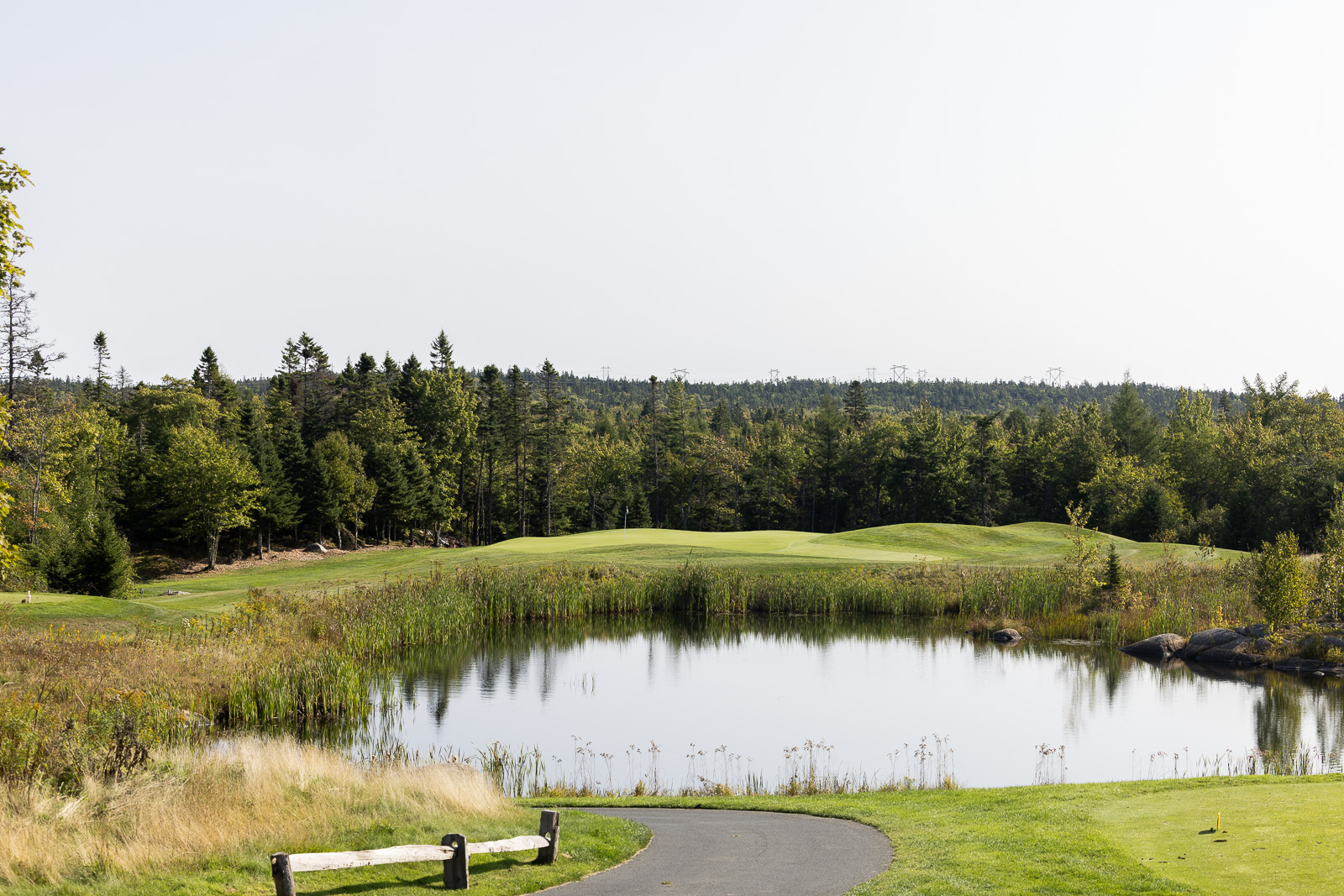When you think “dream golf destination,” your mind probably jumps to Scotland, Ireland, or maybe the Oregon coast.
But here’s what most golfers are sleeping on: Nova Scotia delivers everything those iconic destinations promise: dramatic seaside links, world-class resort golf, stunning coastal drives, and unforgettable hospitality, all within a few hours’ drive from the eastern United States.
After spending a week exploring the region with my dad, I can confidently say: this is one of the best golf trips you can take in North America. Period.
We played five incredible courses, including two that consistently rank among the top 100 in the world. We drove one of the most scenic coastal routes on the continent. We ate lobster rolls that ruined us for all other lobster rolls. And we experienced the kind of genuine Maritime hospitality that makes you feel like you’ve been welcomed into someone’s home rather than just checking into a resort.
This wasn’t just a great golf trip. It was one of those trips that reminds you why golf travel is so damn special in the first place.
The Links at Brunello: One of the Best in Halifax

Of course, our trip didn’t exactly start perfectly.
Our flight into Halifax got delayed, which meant we didn’t touch down until 1:30 in the morning. And when we finally made it to baggage claim, exhausted and ready to grab our clubs and collapse into bed?
Our clubs never showed up.
When we rolled into The Links at Brunello for our 9 AM tee time, about six and a half hours after landing and less than five hours after finally getting to sleep, we had no clubs, no balls, and I didn’t even have proper golf shoes.
Not exactly ideal conditions for tackling one of Halifax’s most challenging courses.
But this is where Nova Scotia hospitality kicked in immediately. The staff at Brunello completely hooked us up. They made sure we had rental clubs that actually fit, got us stocked with balls, and I even found a new pair of shoes in the pro shop that I could justify buying for a product review.
Crisis averted. Sort of.
Located just 30 minutes from Halifax airport, The Links at Brunello was the perfect place to start our trip, even if the circumstances weren’t quite perfect. Designed by Tom McBroom and opened in 2015, this par-72 layout stretches over 7,000 yards from the tips and plays through dramatic, rocky terrain that reminded me immediately of Boston Golf Club.
The course is built on rugged land with rock outcroppings scattered throughout, creating natural obstacles and stunning visual interest on nearly every hole. Combined with elevation changes, water features, and narrow corridors, Brunello demands accuracy and course management from the first tee.
I’ll be honest: I wasn’t quite prepared for the challenge Brunello would bring. Rental clubs and less than five hours of sleep isn’t exactly the winning combination for tackling a track this demanding. But it didn’t stop us from enjoying a beautiful day of golf.
The long par-5 3rd hole is the star of the show. The tee shot plays from a big elevated tee box down into the fairway below, and it’s every bit as fun as it looks. It’s the kind of hole that makes you forget about being tired or playing with unfamiliar equipment and it the ball as far as you can.

The 4th hole, meanwhile, has earned a reputation as one of the top ten most challenging holes in all of Canada. After playing it, I believe it.
Another favorite stretch is holes 14-18. It’s a nice variety of holes, with the par 5, 15th, forcing you to be really strategic with each shot.

The signature rocky vibes are strong throughout these holes, and it proves to be a really strong finishing stretch.

If you’re looking for a great round close to the airport on a trip to Cabot or elsewhere in Nova Scotia, Brunell is a great option.
Fox Harb’r Golf Course: One is Becoming Two
After Brunello, we made the hour-and-a-half drive north to Fox Harb’r, and what we found there was unlike anything else on the trip.
Fox Harb’r Golf Resort sits on 1,100 acres of oceanfront property along the Northumberland Strait. Originally developed by Ron Joyce (co-founder of Tim Hortons) in 2000, the property features a Graham Cooke-designed championship course that has hosted Tiger Woods, who set the course record of 63 back in 2009.
But here’s where it gets interesting: Fox Harb’r is currently in the process of adding a second course. Which means the round we played wasn’t the traditional layout, but was a mashup of what will eventually become two distinct courses.
We played what will be the front nine of the Vineyard Course, and for our back nine, we played what will be the front nine of the Ocean Course. It’s a transitional moment for the property, and I can’t wait to come back when both courses are complete, because they’re going to provide two very different golf experiences.

Doug Carrick and Tom McBroom are doing the work on the new courses, which should be completed in 2026.
The nine Ocean Course holes we played were particularly compelling.
The 2nd hole (our 11th) is a fantastic drivable par-4 that forces you to really think about club selection off the tee. Do you go for it? Lay back? The risk-reward is perfectly balanced.
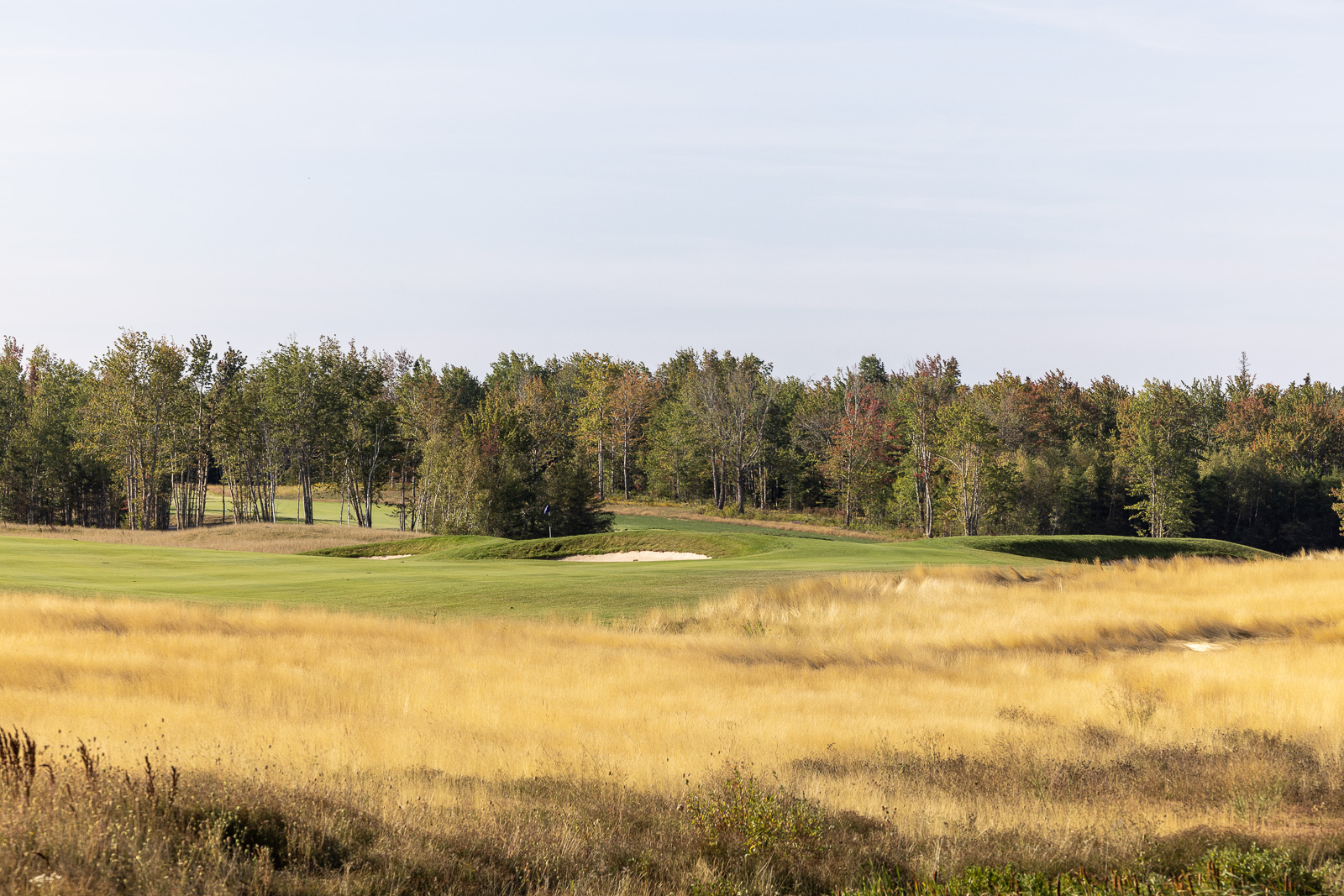
But the real highlight is the stretch from holes 7 through 9 — an absolutely spectacular run of golf along the water. The 7th (our 16th) is a medium-length par-3 that plays right along the ocean. Then you roll directly into the par-5 8th, which hugs the coastline for its entire length.

And here’s the crazy part: this isn’t even the most scenic golf on the property. That distinction is reserved for the back nine holes of the Ocean Course, which were still under construction during our visit. If what we played was this good, I can only imagine what’s coming.

One of the coolest details about the course? You can still see remnants of the old lobster-processing plant that occupied the property before it became a resort. It’s a subtle reminder that this land has deep Maritime roots, even as it’s been transformed into a world-class golf destination.
Fox Harb’r is remote, challenging, and evolving — and that combination makes it one of the most unique stops on any Nova Scotia golf itinerary.
Fox Harb’r Resort: A Luxurious 5 Star Resort
Driving into Fox Harb’r is an experience in itself.
You’re truly out in the middle of nowhere, rolling farmland and forests for miles, when suddenly, about a mile from the entrance, a big, fancy black fence appears and signals that you’re getting close to something special.
The entrance is grand, with flowers everywhere and an immediate sense that this isn’t your typical golf resort. And it’s not. Fox Harb’r is considered one of the only true five-star resorts in all of Canada, and after staying there, I get it.
The accommodations are unique. Rather than one large hotel building, the resort features multiple smaller buildings scattered across the property, each with around six rooms. Ours sat between the private landing strip (yes, if you’re fancy enough, you can fly your plane directly to the resort) and the back nine of the Ocean Course.
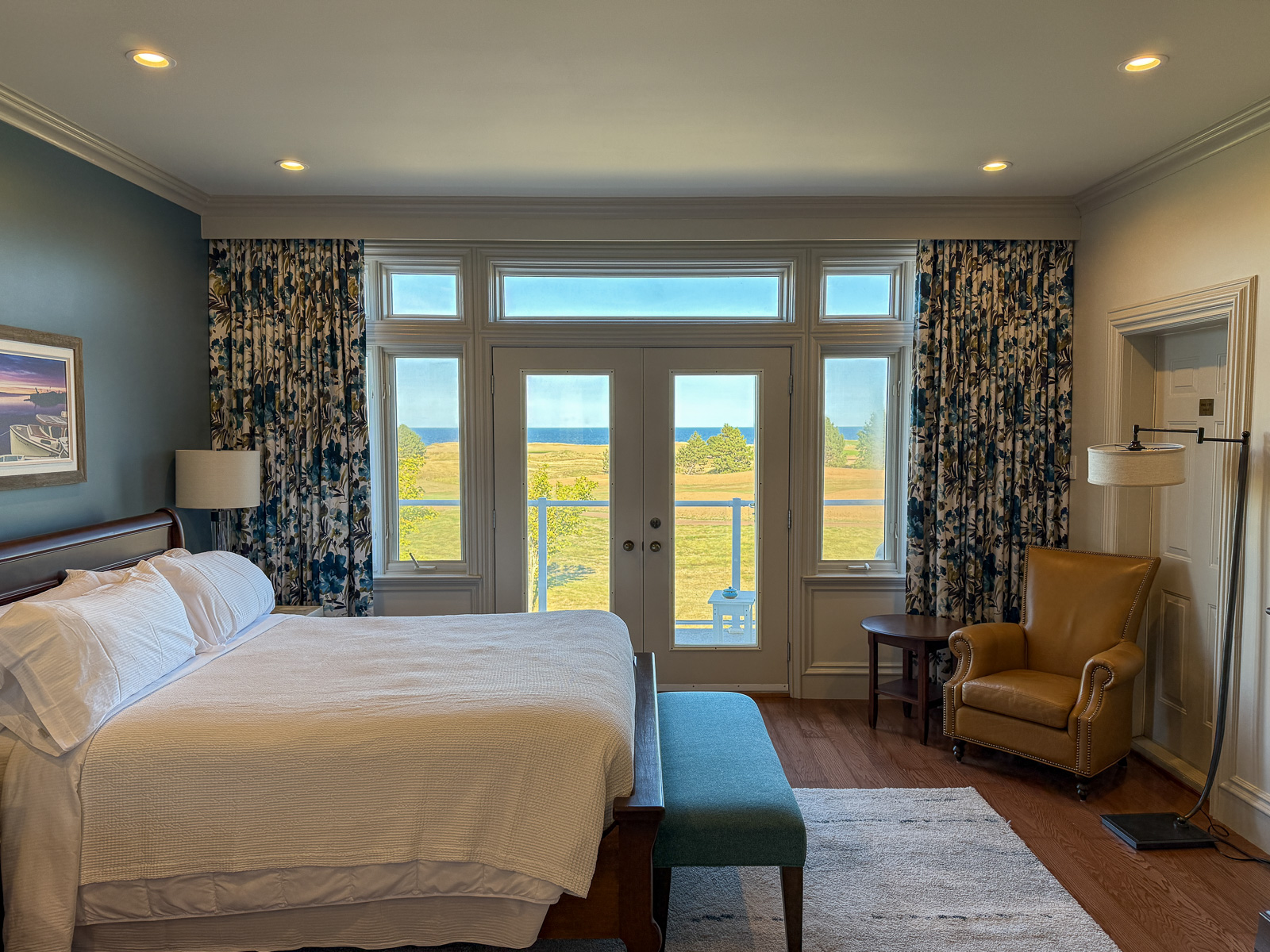
Our room was spacious and exceptionally comfortable, with a private balcony overlooking the course and the water beyond. Waking up to that view made the early tee times worth it.
The food at Fox Harb’r was excellent across the board, but we treated ourselves to the fanciest meal of the entire trip at their fine dining restaurant. The seafood tower was as good as it gets — fresh, perfectly prepared, and absolutely massive. Their cocktails were surprisingly excellent for a resort this remote, which isn’t always a given.
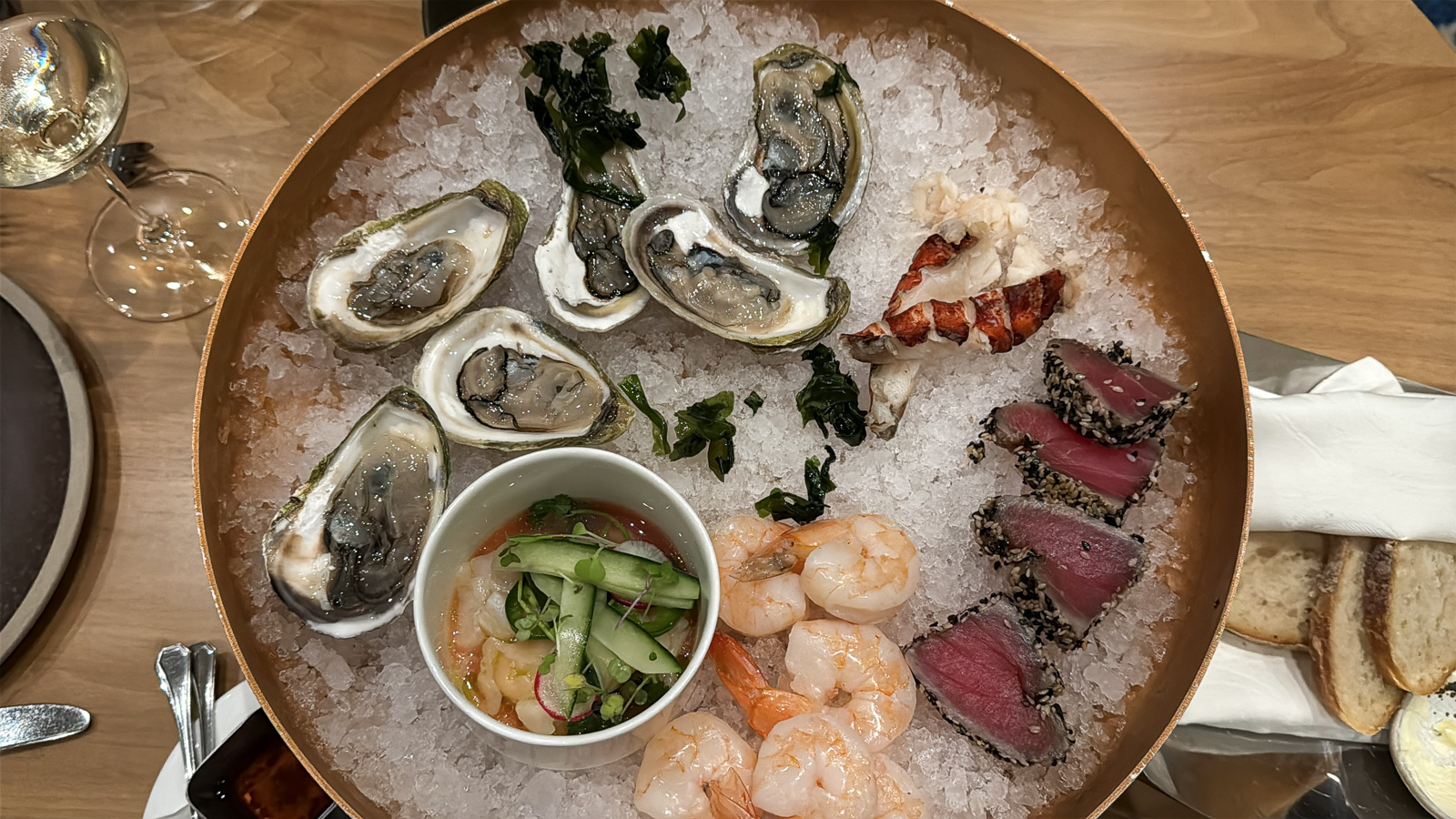
But the real standout amenity? The spa.
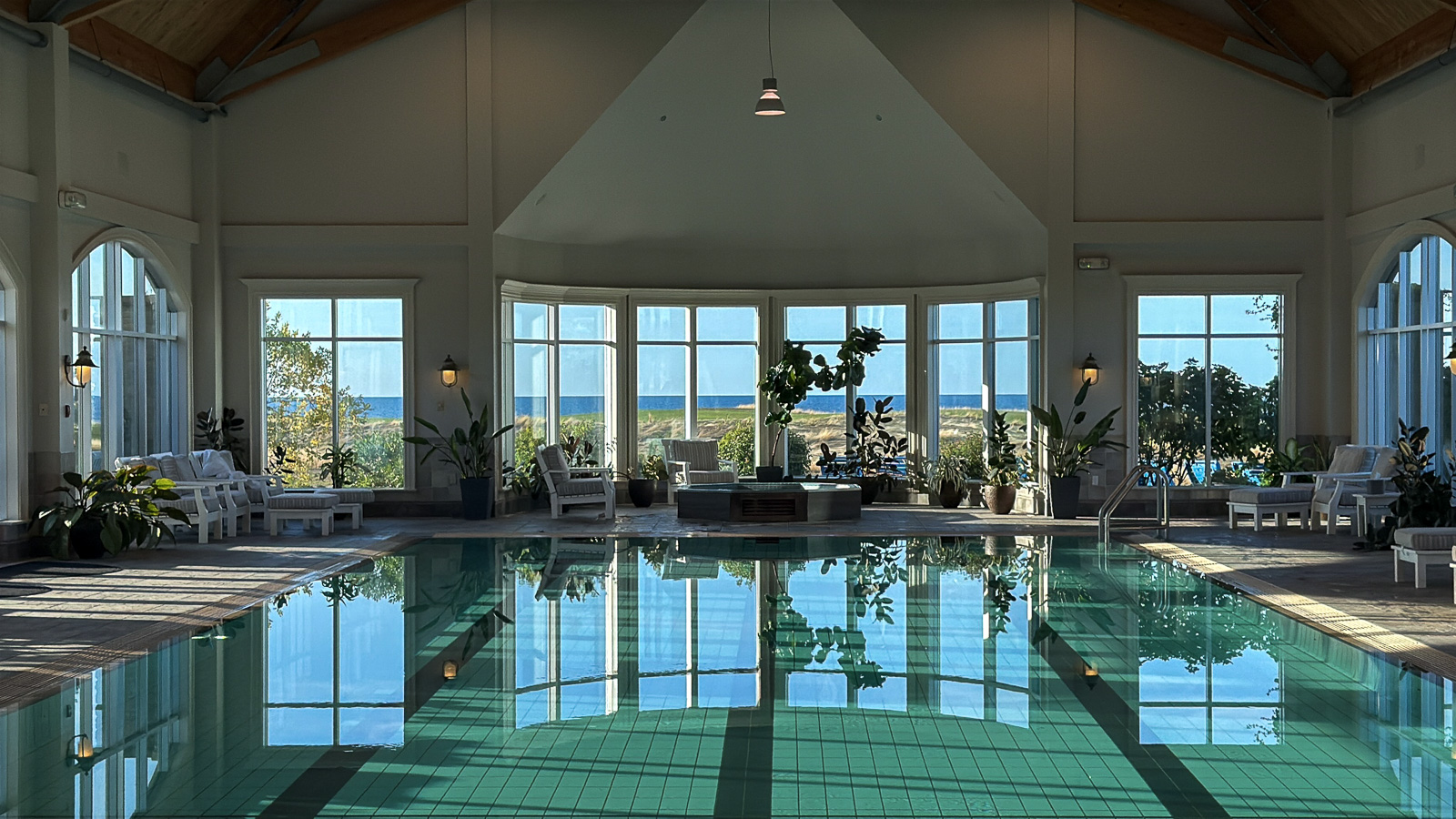
Fox Harb’r has one of the best spa facilities I’ve ever seen. It’s brand new and includes a dry sauna, steam room, cold plunge, salt room, and a spectacular indoor pool that feels more like something you’d find at a European wellness retreat than a golf resort in rural Nova Scotia.
Despite our tight timeline, I had to carve out 45 minutes to indulge. It was worth every second.
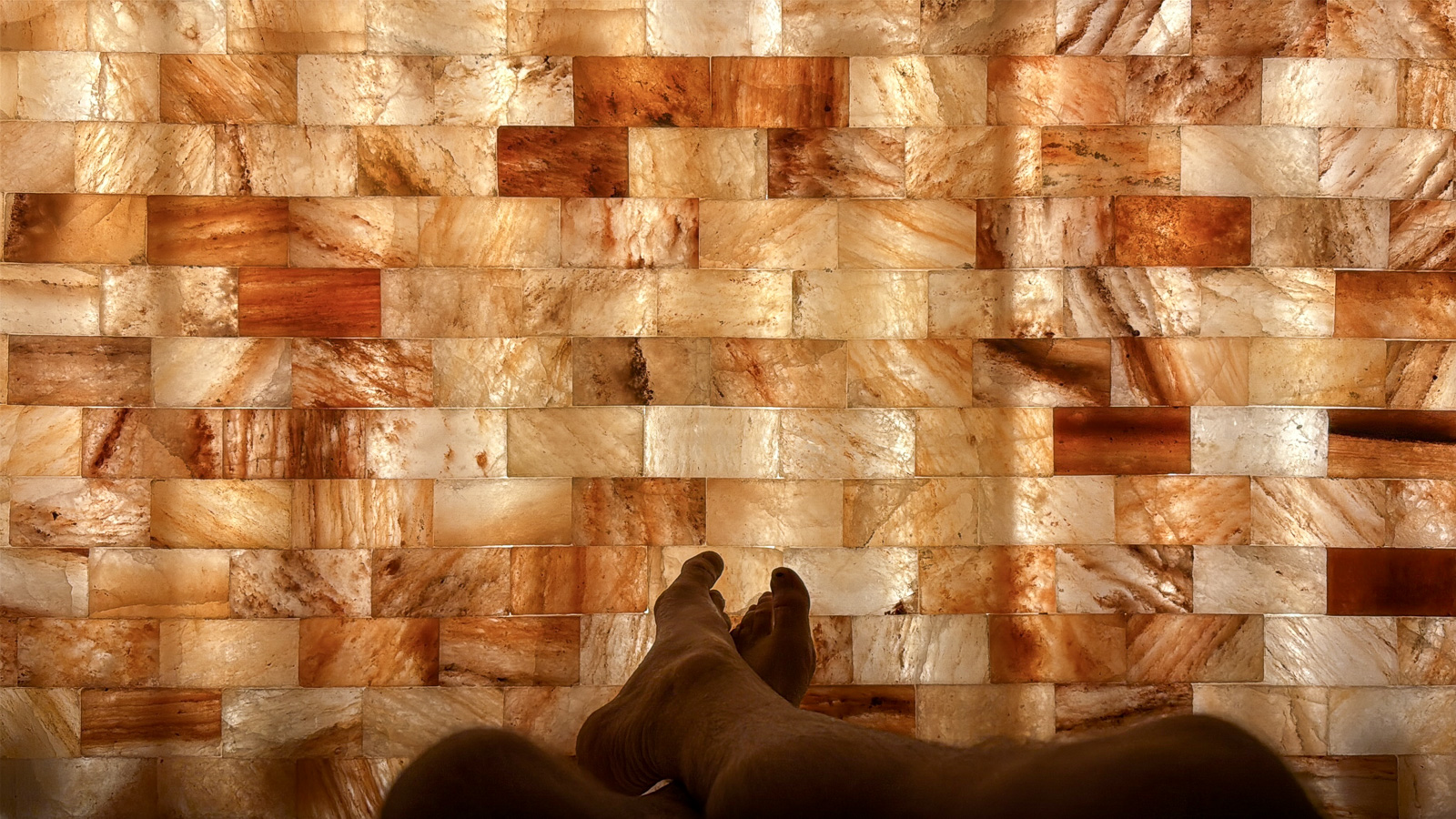
In addition to the golf and spa, the property includes a marina, hunting lodge, and even its own winery. It’s the kind of place where you could easily spend three or four days without ever feeling like you need to leave.
Fox Harb’r isn’t just a golf resort — it’s a complete luxury escape in one of the most unexpected corners of Canada.
Cabot Cape Breton: World Class in Every Way
It’s about a 2.5 hour drive from Fox Harb’r to Cabot Cape Breton, again, through beautiful, rural countryside.
We were less than 5 minutes away from Cabot, and it definitely didn’t look like we were about to stumble upon a town, let alone a world-class golf resort. But that’s exactly what happened.
Inverness used to be an old mining town that had fallen on hard times. But a few decades ago, the town did a land reclamation project on the mine that, as it turns out, made it wonderfully appealing for a golf course – and thus Cabot Cape Breton was born.
Ok, it wasn’t quite that simple, but I’ll do a large post all about Cabot soon where I’ll dive a bit more into the history.
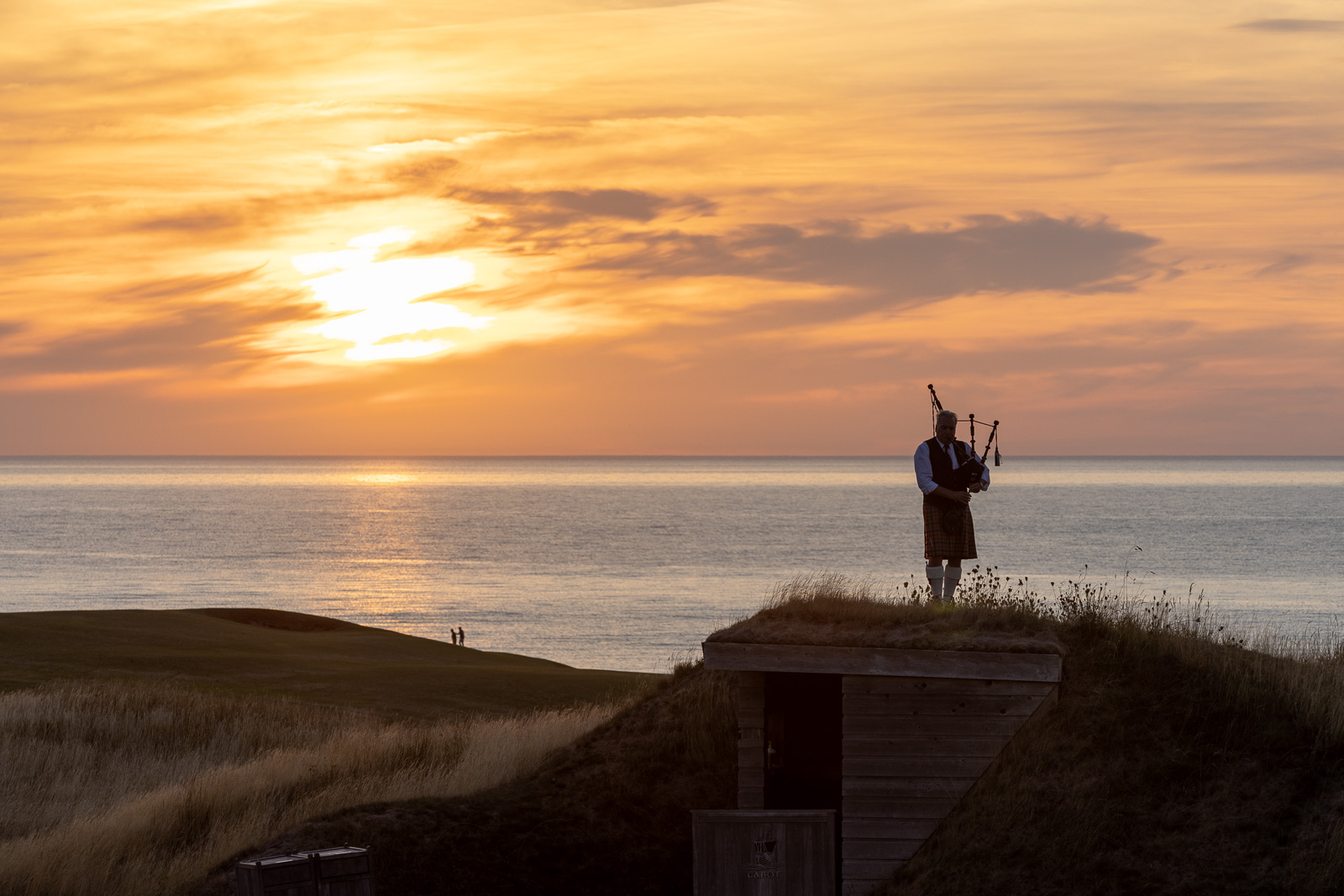
When we arrived, the weather was absolutely perfect. A few nights a week, they have a bagpiper come out at sunset and play. Watching it truly provided one of those “pinch me, how did we get here moments.”
But for as special as that was, it was the golf that was the real star of the show.
Cabot Links: The First True Links Course in Canada
Cabot Links was designed by Canadian architect Rod Whitman and opened in 2011 as Canada’s first authentic links course. The course was created by Ben Cowan-Dewar with financial backing from Mike Keiser, the mastermind behind Bandon Dunes. Golf Digest named it the world’s Best New Course in 2012.

One of the most common sentiments you’ll hear from people who’ve played both Cabot courses is that Cliffs is the eye candy that grabs your attention first — but the more you play, the more you realize Links is actually the better golf course.

Despite only playing each of them once, I found them each equally compelling for very different reasons.
The par-4 6th, known as the Harbor Hole, is the signature at Links. It’s a dogleg left that plays around a working harbor, with elements of a classic cape hole where you can decide just how aggressive you want to be off the tee.
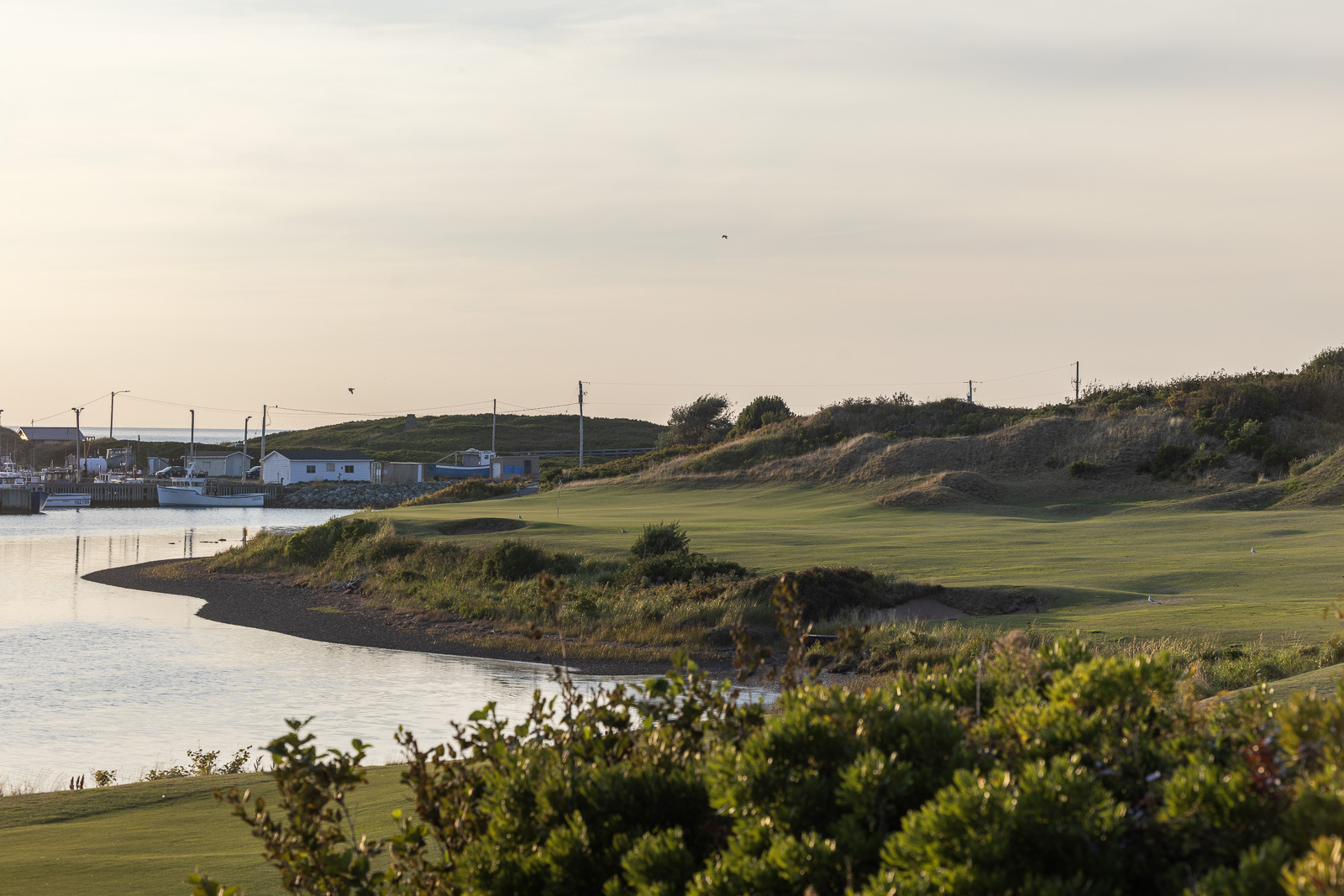
I took a more aggressive angle than I probably should have and got lucky with a drive that ended up within putting distance of the green. It’s the kind of hole that rewards boldness but punishes carelessness.
The par-5 11th was another standout for me. This is a wild, disorienting hole that you need to play a few times to fully understand the best way to navigate it. But here’s the most important thing you need to know: don’t go short right on your approach. You’ll end up 50 feet below the hole, and making an up-and-down from there would take a couple of seriously impressive shots.
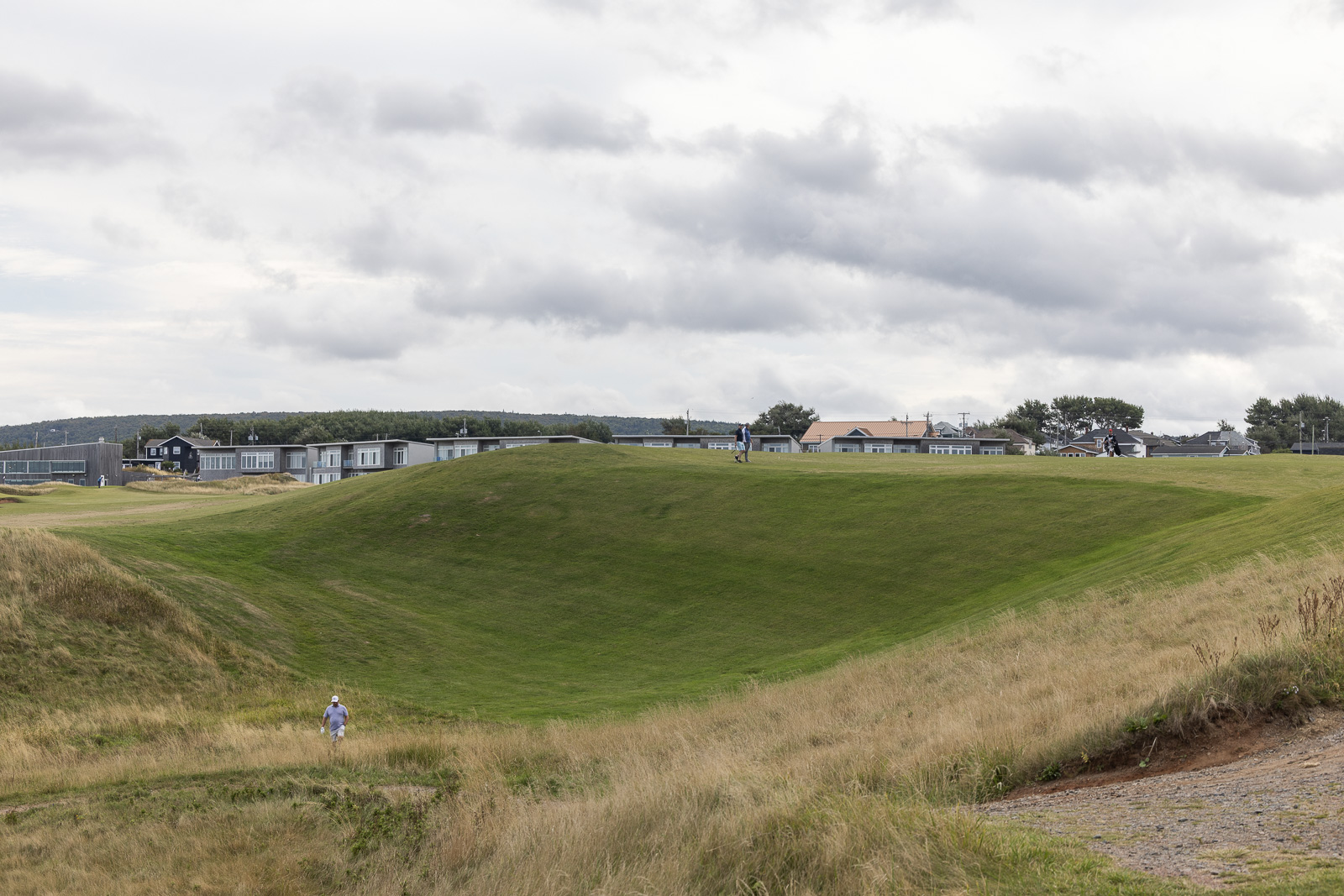
Cabot Links feels like it could have been there for a hundred years. It’s understated, strategic, and rewards thoughtful play over sheer power. It’s the kind of course that gets better every time you play it.
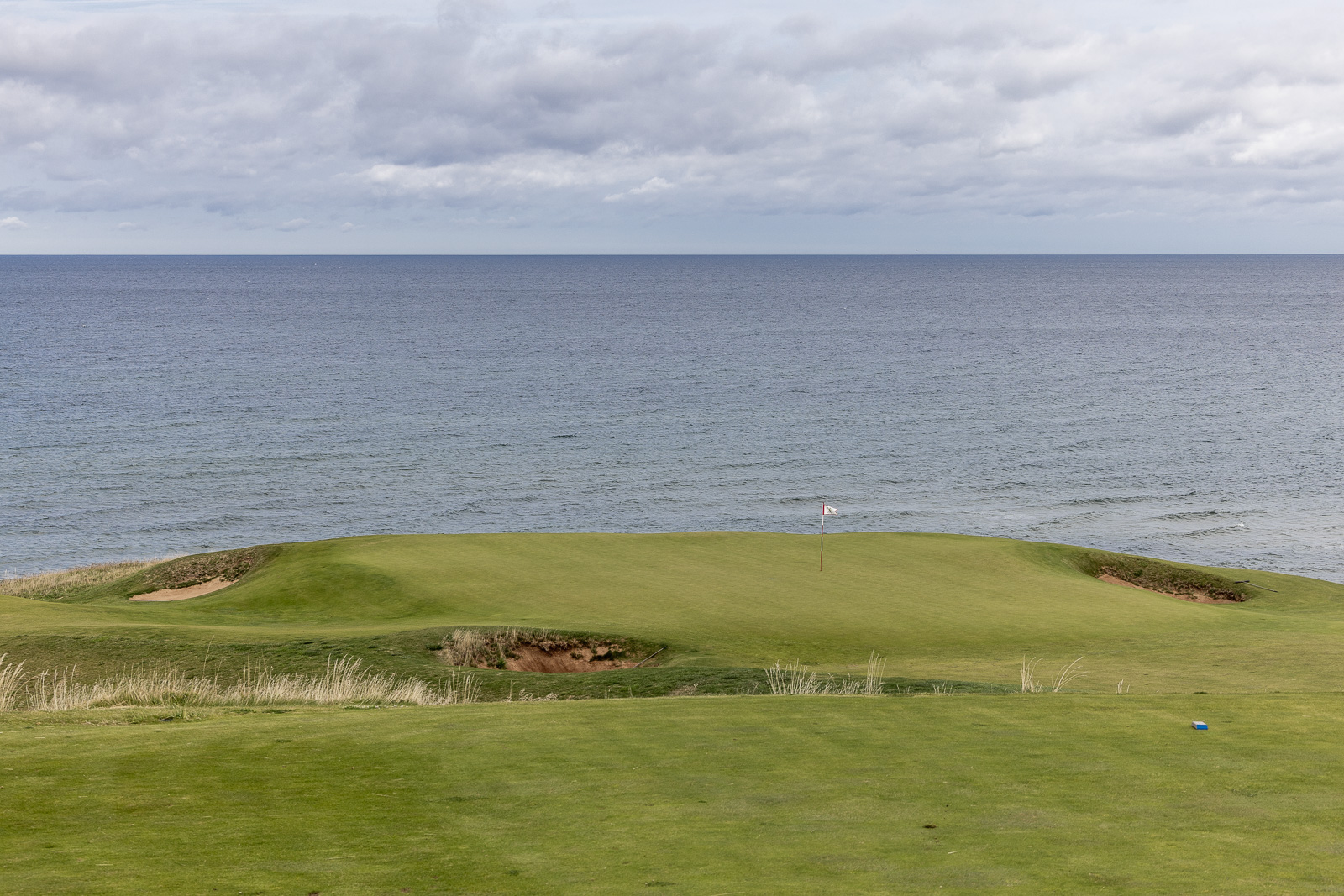
Cabot Cliffs: The Ultimate Modern Links Course
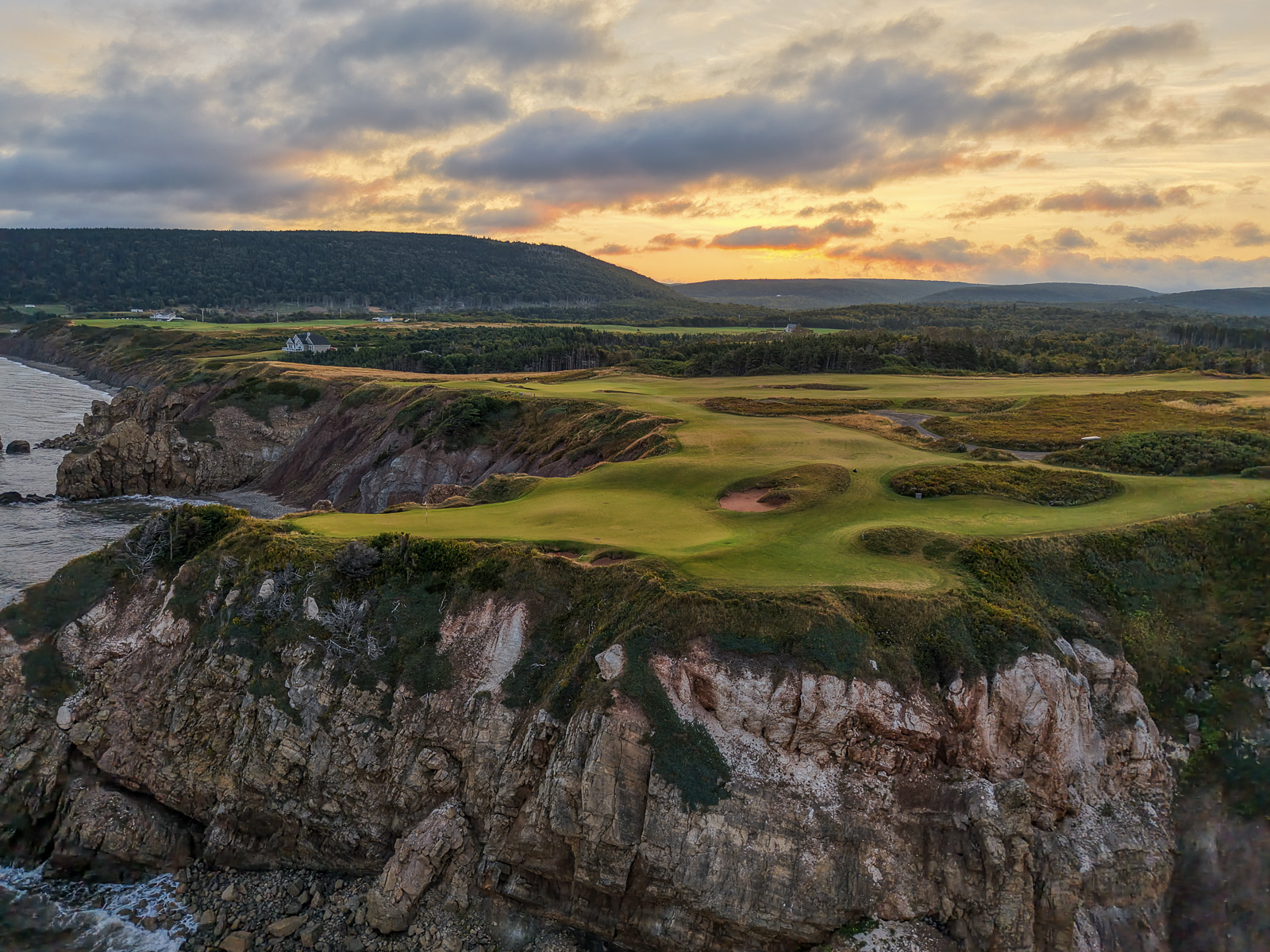
While Links has stunningly beautiful holes, it’s the newer Cliffs Course that hits you with the drama at first glance.
Designed by Bill Coore and Ben Crenshaw and opening in 2015, Cabot Cliffs is quite simply one of the most fun golf courses I’ve ever played.
Where Cabot Links feels like it could have been there forever, Cliffs feels decidedly modern. There’s more elevation change, more dramatic views, and in many cases, more fun golf shots to play.

The par-4 2nd caught me completely off guard. An elevated tee leads down to a wide fairway, but the green is perched up on the opposite side of a large hill sitting directly in the middle of the fairway. If you want the best look at the pin, you’ll need to veer either right or left, bringing more trouble into play. It’s strategic, thought-provoking, and totally unique.

Every hole has something interesting going on, and just like Links, you’ll find stunning views across nearly all 18 holes.
But the climax is absolutely holes 15 through 18. This is one of the most fun stretches of golf you’ll ever play.
The par-5 15th heads directly toward the ocean, with strategically placed bunkers that force you to think about every shot rather than just bombing away.

The 16th is the signature par-3. It sits perched out on a cliff, and you have to hit directly over the beach to a precarious green. Don’t fall for the sucker pin if it’s tucked way out to the right — trust me on that one.

The 17th requires another tee shot directly over the beach. This shot feels like a slightly less daunting version of the 6th hole at Sheep Ranch at Bandon Dunes. A solid drive will leave you with a wedge into a downhill infinity green. It’s admittedly a bit quirky, but it’s absolutely a blast to play.

The 18th finishes with a reachable par-5 that plays right up the coast. Watch out for the area short and right of the green — you can find yourself in some daunting rough that makes for a tough up-and-down. I speak from experience.
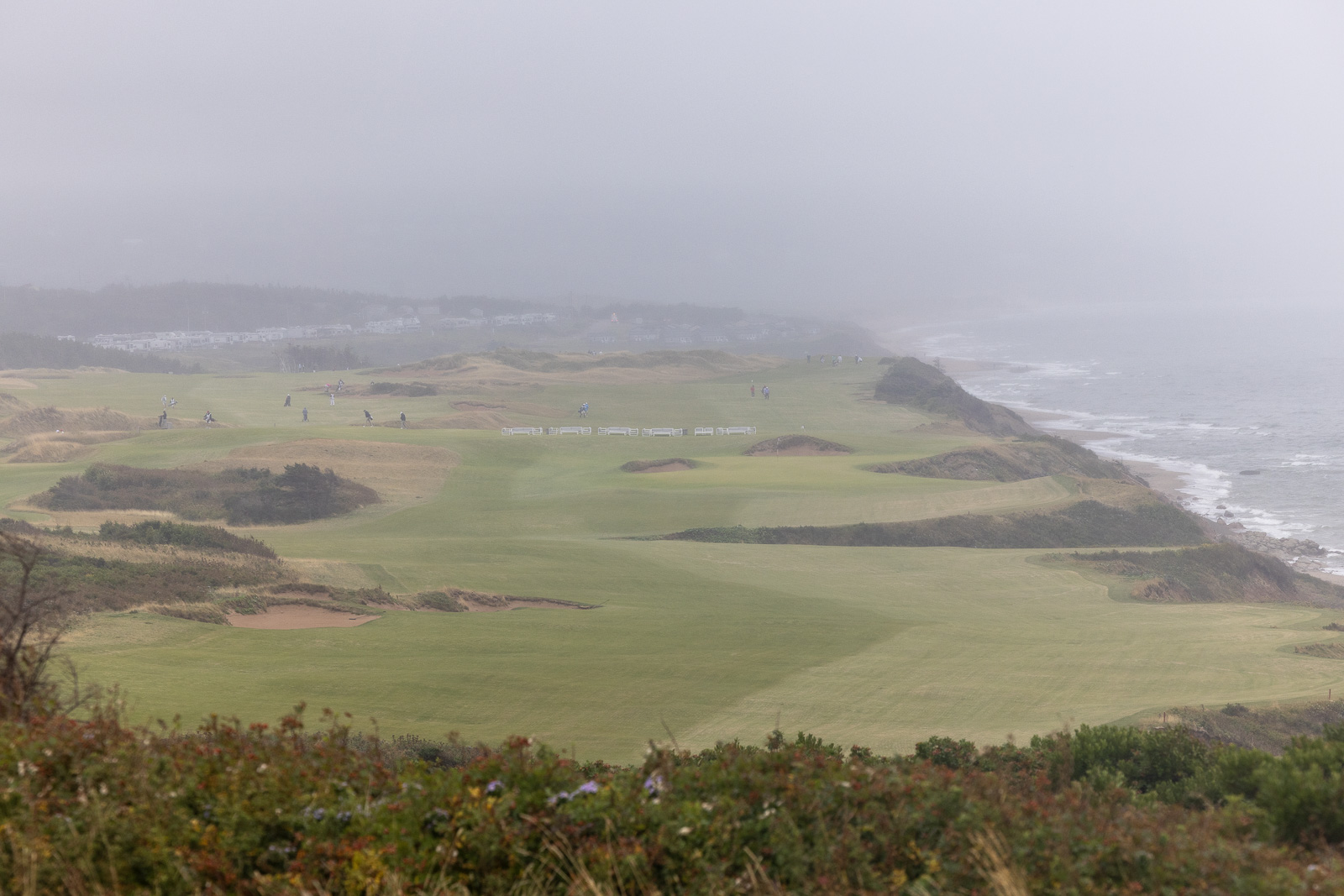
This is the kind of golf course that makes you want to run right back out and play it again the moment you finish.
It’s not hard to see why both of these courses are ranked in the Top 100 in the world, but each earns its ranking for very different reasons.
The Nest Par 3 Course
Finally, there’s The Nest, an 11-hole par-3 course that’s exactly what you want to see at a resort like this.
It’s the kind of bonus course where you can grab a few clubs, a putter, a beer, and just go have a blast.
Don’t be fooled though, this course has teeth. The Nest had the fastest greens of any of the three courses at Cabot, and if you hit it anywhere but the green, you’re likely to find trouble quickly.
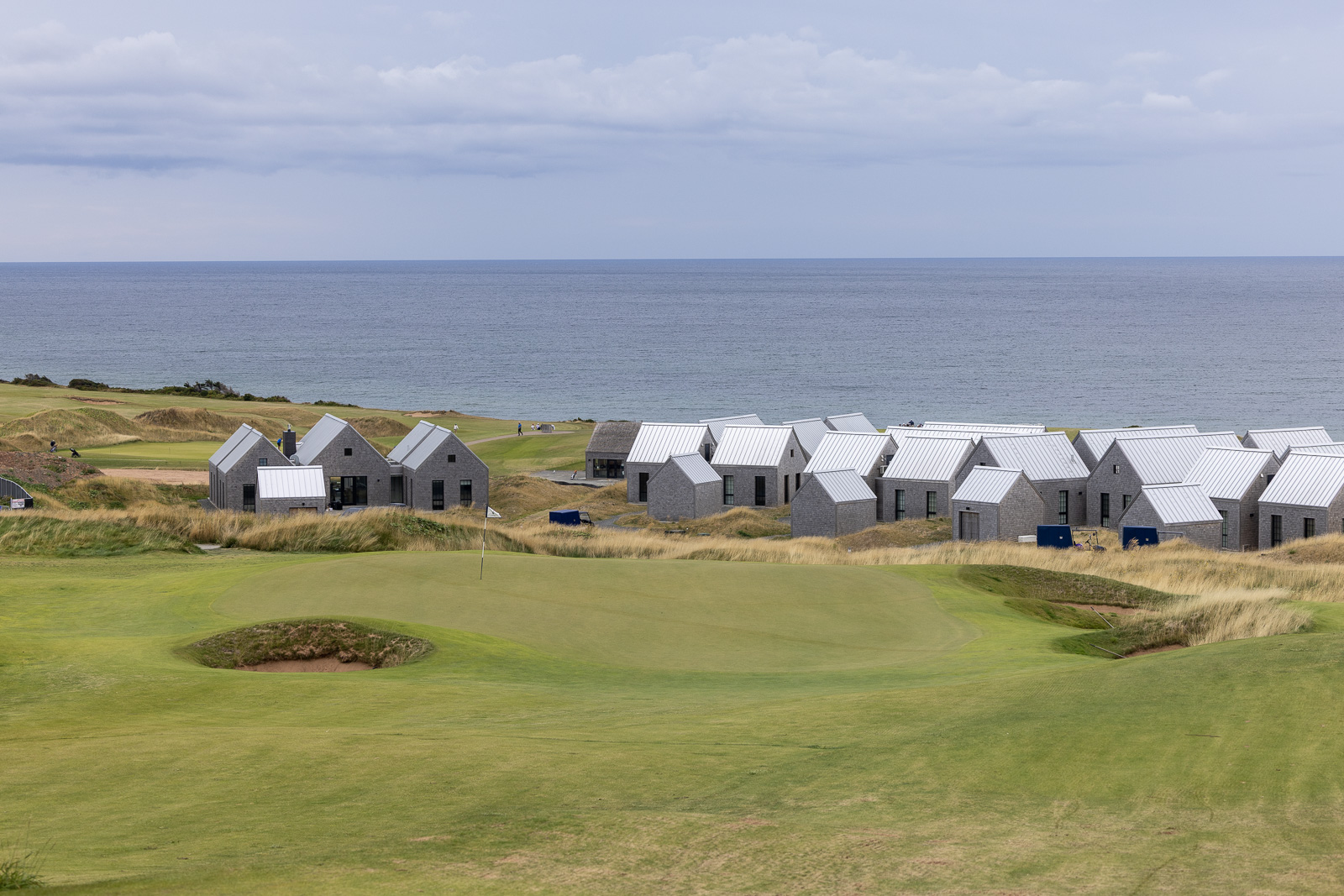
But here’s the coolest part: you can play night golf here. I absolutely did not expect to play night golf at a top-100 coastal resort in Nova Scotia, but there we were, teeing it up at 8:30pm under the lights.
The experience is fun, though it definitely adds to the challenge. Judging distances and reading greens at night is no joke.
But just like all the courses at Cabot, you’re given a delicious cookie on the first tee to help ease any pain you might feel along the way. It’s one of those small touches that make Cabot feel so special.
There’s Way More to Do at Cabot than You’d Expect
Inevitably, you’ll hear many comparisons of Cabot to Bandon Dunes. And frankly, for good reason. Those are the only two resorts in the world that feature two or more courses in the Top 100.
But unlike Bandon, which is really pretty much golf only – there’s actually a surprising amount to do at Cabot.
They have clay tennis courts..
There’s ax-throwing…
Hiking trails…
A game room…
And while the town of Bandon is only about a 15-minute drive from the resort, here, Inverness is literally right out the front entrance.

The food and accommodations at Cabot are all first rate. From the casual Whit’s Public House, to the more elevated Panorama dining option.
The most unexpected dining option was Coore’s Lobster Shack. Which is hidden out of place on the drive into the Cliffs Course – but if you’re looking for amazing food in a fun and somewhat casual setting, this is it.
There’s a huge variety of rooms and lodging options at Cabot. From hotel rooms overlooking the Links Course, to multi-bedroom homes and cottages. No matter what you choose, you’ll end up with something very nice, and very comfortable.

Our two-bedroom Hillside Home was perfect, and the outdoor firepit made for a particularly enjoyable spot to wind down with a beer at the end of the day.
The bottom line is that Cabot truly is a world-class destination in every sense, and is worth the effort it takes to get there.
The Cabot Trail Drive
The Cabot Trail is a 186-mile road along the Nova Scotia coastline and is considered one of the most beautiful drives on Earth.
Leaving Cabot Cape Breton and heading toward Ingonish, the road twists and turns through the Cape Breton Highlands. It’s a mix of rugged coastline, rolling mountains, and stretches of forest that make you feel like you’re driving through a postcard.
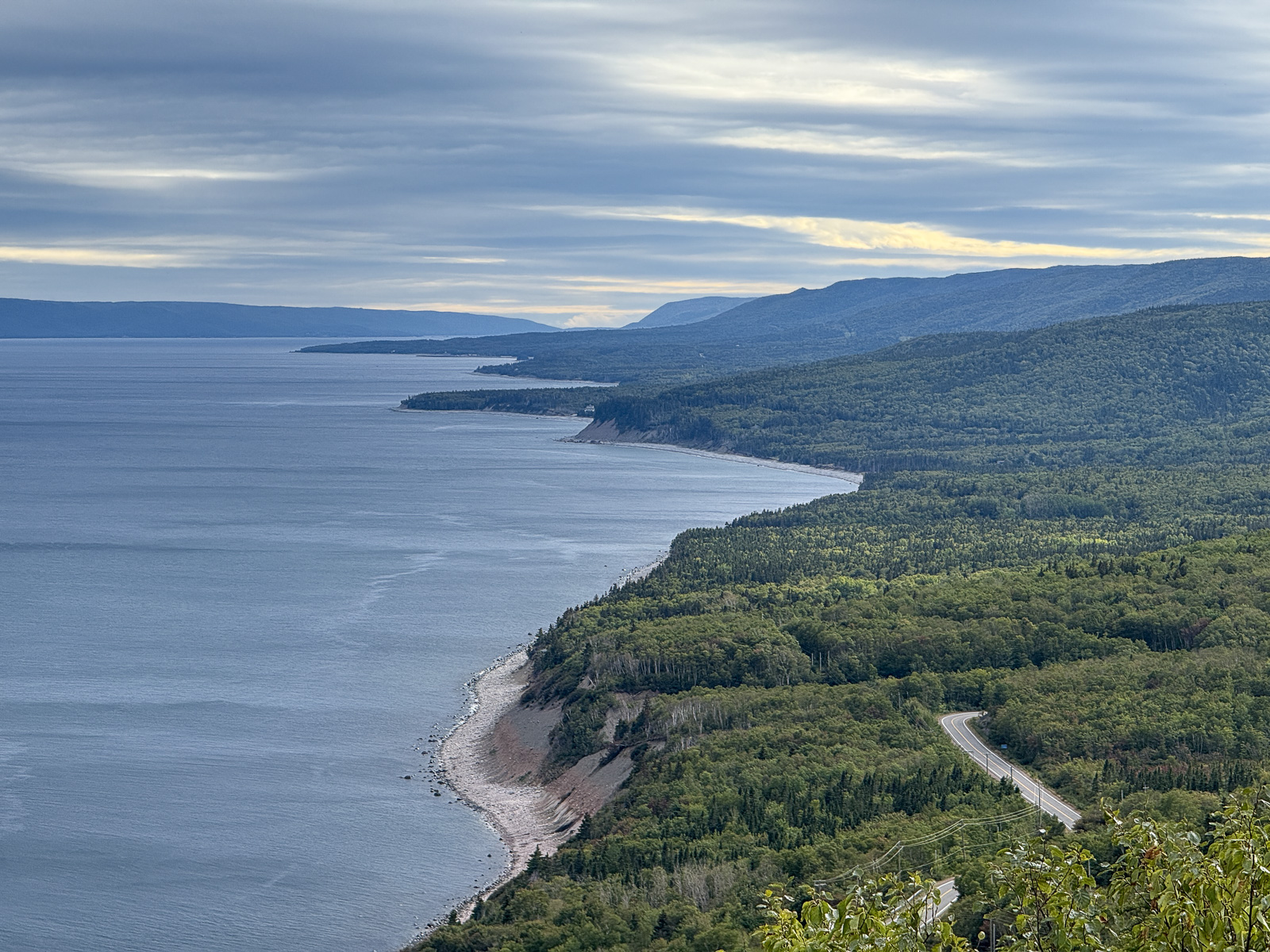
One minute you’re climbing into the clouds, looking out over the Gulf of St. Lawrence. The next you’re hugging the cliffs with the Atlantic crashing far below.
It’s the kind of drive that makes you slow down, not because you have to, but because you want to. Every curve reveals a new view that’s somehow better than the last.
Actually, if I’m being honest, it makes me wish I’d splurged and rented a Porsche or something equally as fun for this drive.
We stayed for a night just outside the town of Ingonish, before heading over to Highland Links and the Keltic Lodge the following morning.
Cape Breton Highland Links: “The Cypress Point of Canada”
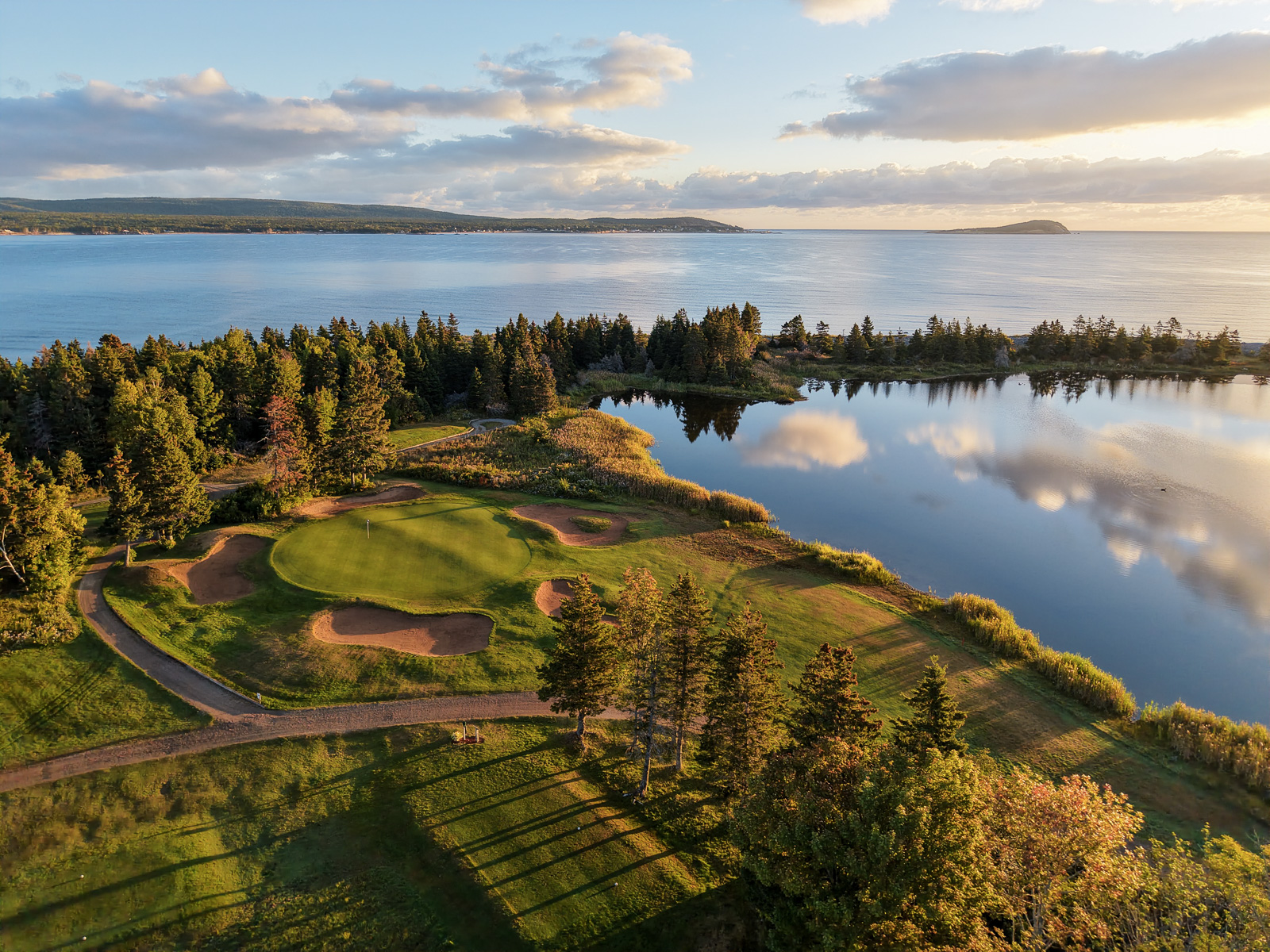
With Highland Links, you’re getting a completely different golf experience than any of the other four courses on this trip.
This course was designed by legendary Canadian architect Stanley Thompson and opened on July 1, 1941. Along with Banff Springs and Jasper Park Lodge, Highland Links completes his holy trinity of public Canadian courses.
Thompson called this his “mountains and ocean” course, and even referred to it as his “masterpiece.”
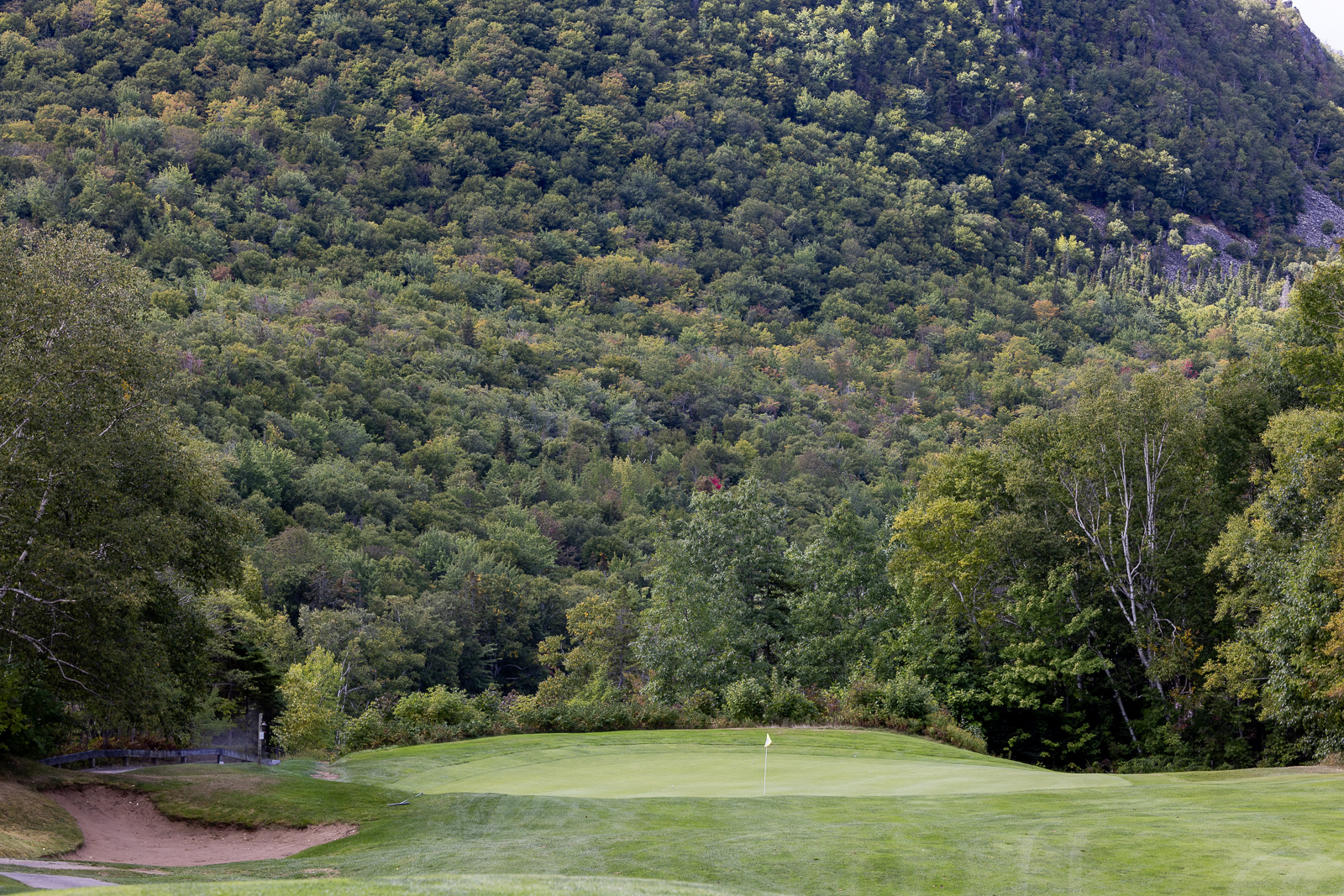
Considering how phenomenal those other two courses are, that’s saying something. Some have even referred to it as the Cypress Point of Canada.
And honestly? That might be a bit of a stretch.
Don’t get me wrong, Highland Links is absolutely worth playing. But there are a couple of important things to understand about what you’re signing up for.
The course is located inside Cape Breton Highlands National Park and is owned by Parks Canada. While this makes for a beautiful, natural setting, it also creates two significant challenges:
- Environmental restrictions. Parks Canada has strict rules about what can and can’t be done to maintain and improve the course.
- Budgetary restrictions. As a public course within a national park, Highland Links doesn’t have the same resources as resort courses like Cabot or Fox Harb’r.
The combination of these factors means the course conditioning isn’t quite up to the standards of the other tracks we played. Nature has reclaimed some aspects of the original design, and you’ll notice it throughout the round.
But don’t let that scare you away.
Despite being a different course than what Thompson originally built in the 1940s, Highland Links is still one of the best courses in Canada. It feels like a true jungle adventure for much of the round, with holes carved through dense forest that make you feel completely removed from civilization.
The stunning par-3 3rd is one of the most beautiful one-shotters I’ve played anywhere. And to follow it up with the mid-length 4th hole, which features a super unique “volcano green”, is fantastic.
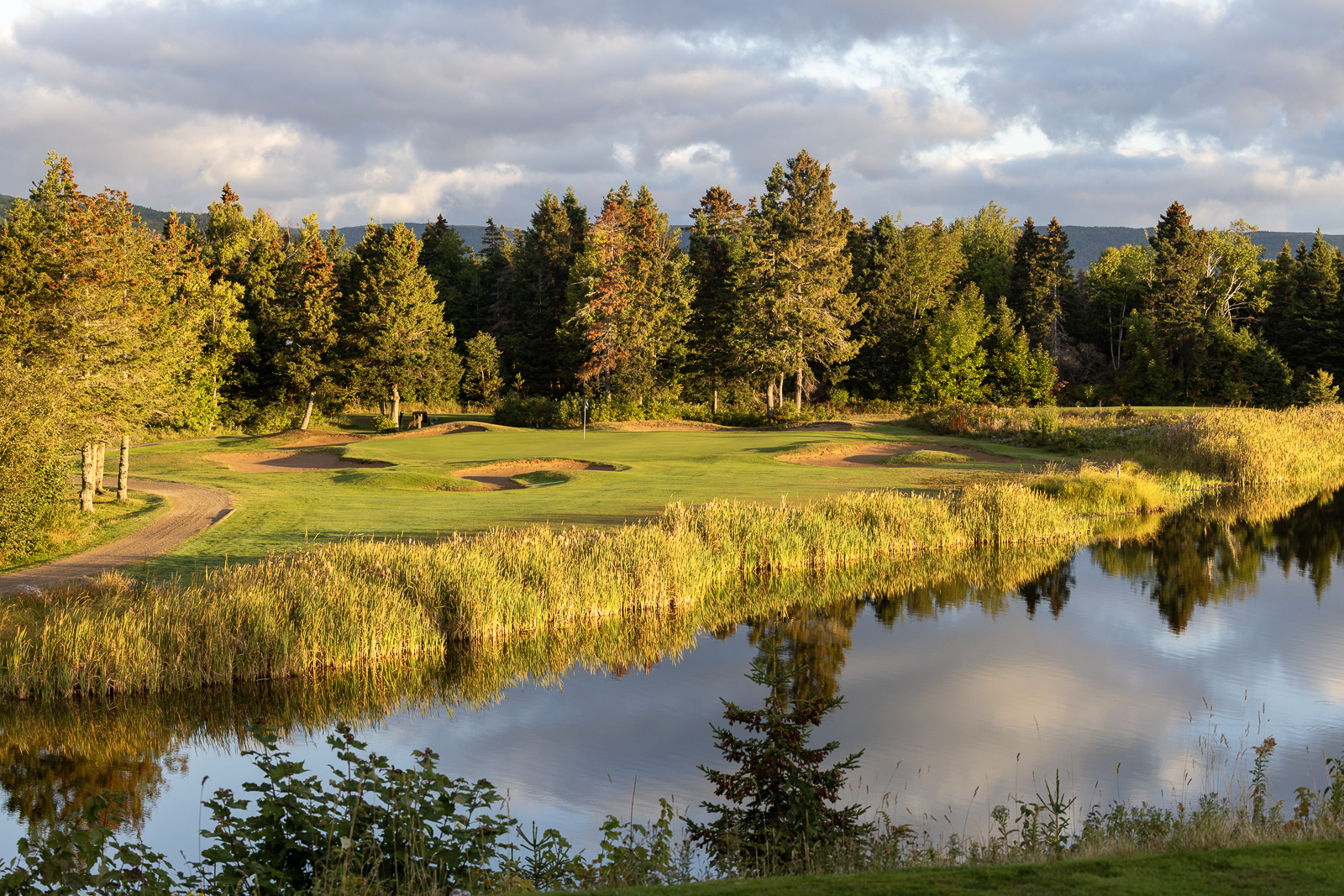
Highland Links uses a true out-and-back routing, so you head about two miles deep into the forest before turning around. It really makes the course feel like an escape, and there are holes here that I’ve simply never experienced anything like before.
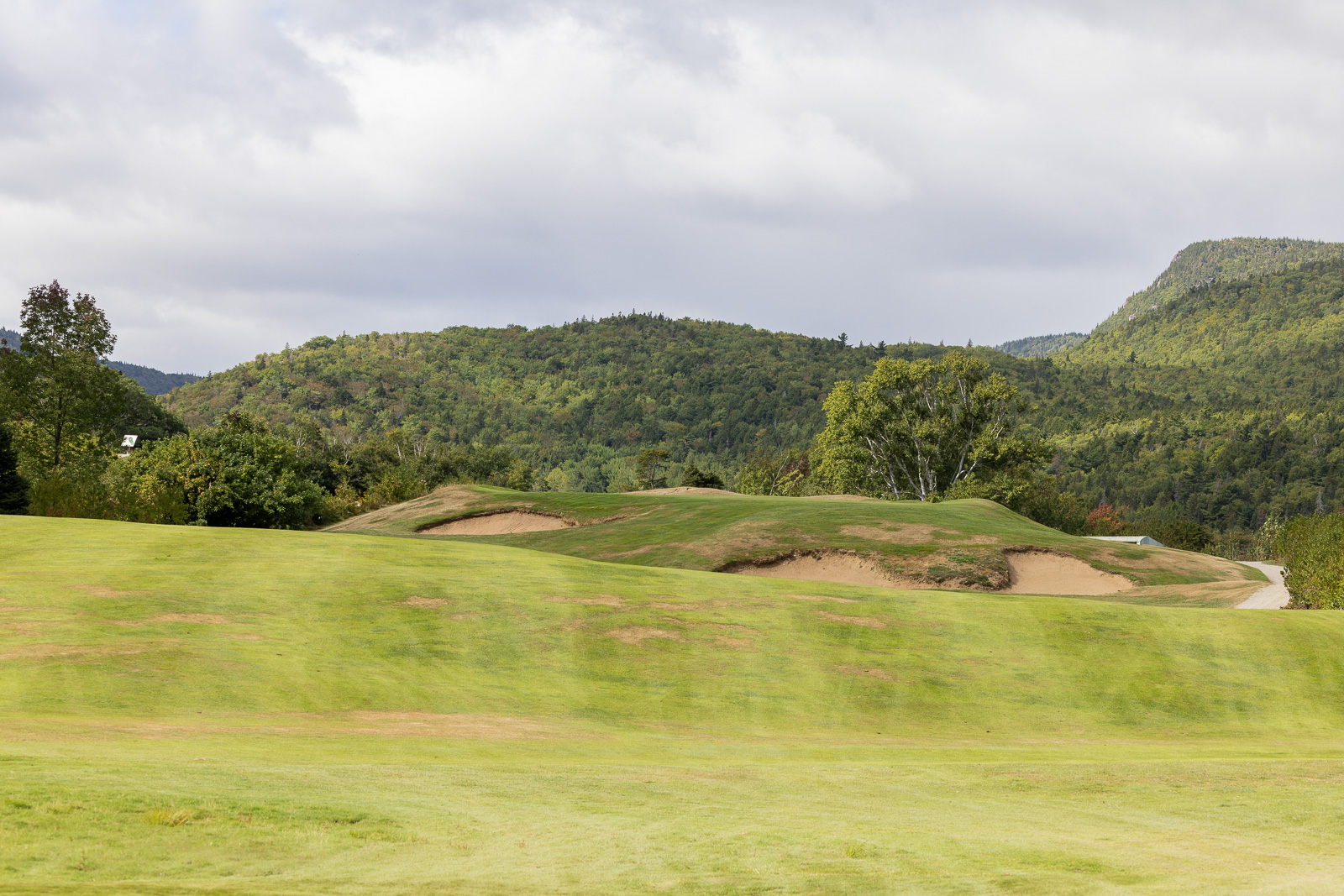
If you’re traveling to Nova Scotia for golf, you’d be doing yourself a disservice not to make the drive to see one of the most historic courses in North America.
And if you do, make sure you stay at….
The Keltic Lodge
What the Fairmont Banff Springs and Jasper Park Lodge resorts are to their respective golf courses, Keltic Lodge is to Highland Links.
This historic property sits on the Middle Head Peninsula, perched high on the cliffs overlooking the Atlantic Ocean. The views from the lodge, looking out over Ingonish Bay with Cape Smokey rising dramatically in the distance, rank among the top ten best hotel room views I’ve had in all my travels.

The lodge itself opened in 1939 and retains much of that historic Maritime character. The accommodations range from rooms in the main lodge to standalone cottages, and while the property isn’t as modern or luxurious as Fox Harb’r or Cabot, it has a charm and authenticity that perfectly complements the Highland Links experience.
While you’re here, be sure to spend as much time outdoors as possible. There are hiking trails throughout the property, including the Middle Head Trail that starts right behind the lodge and offers spectacular ocean views. The nearby beach is beautiful, and if you have time, the gondola ride up Cape Smokey is well worth it.
This is an outdoor person’s dream destination: hiking, whale watching, beaches, and of course, golf, all in one stunning location.
Keltic Lodge isn’t about over-the-top luxury. It’s about experiencing a piece of Canadian golf history in one of the most beautiful settings imaginable.
A Quick Stay in Halifax
It was about a five-hour drive back to Halifax to wrap up the trip.
I honestly didn’t know much about the city before we arrived, so I was excited to get out, walk around, and see what it was all about.
The first stop was Citadel Hill, a massive fort built to defend Halifax from an invasion that, as it turns out, never came. These days it’s a national historic site, and the best spot in town for sweeping views and a sunny patch of grass when the weather cooperates.

We stayed at the historic Lord Nelson Hotel downtown, which was a real treat. You never know if “historic” means charming or just old and tired, but the Lord Nelson hit the balance perfectly. The rooms felt modern and comfortable, while the hotel itself still carried the character and elegance of its 1920s roots.
Wandering downtown, I got subtle Seattle vibes: steep streets, harborside views, and a ton of energy. It’s a city that surprised me in all the best ways, and one I definitely want to spend more time exploring next time around.
Final Thoughts on Our Nova Scotia Road Trip
Back in 2009, I published a bucket list of all the things I wanted to do in life.
Two of those items were simple:
- Take an international trip with my mom.
- Take an international trip with my dad.
It took me longer than I’d like to check those off, but 2025 made up for it with three international trips in one year.
- Vietnam with my dad in April.
- London with my mom in June.
- And now, Nova Scotia with my dad again.
To have that kind of time together, just the two of us, a thousand miles on the road, surrounded by some of the most beautiful scenery in North America, that’s something I’ll never take for granted.
Add in phenomenal seafood, and five golf courses that each have their own personality, and it’s hard to imagine a better trip.
This is what I love about golf.
Without Breaking Eighty, I probably never would’ve ended up in Nova Scotia. But what I found was a place, and an experience, that I’ll remember for the rest of my life.
If you’re looking for a destination that combines world-class golf, stunning scenery, and the kind of memories that stick with you, Nova Scotia should be at the top of your list.

